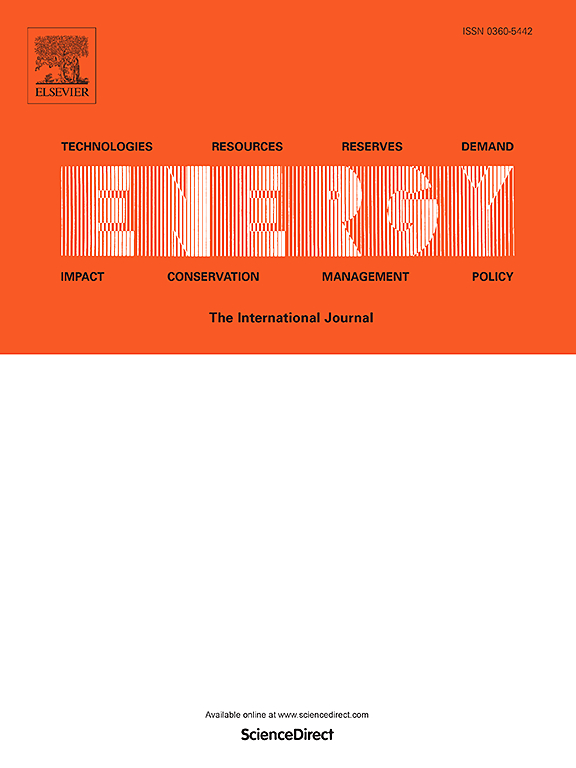新型层叠式颗粒流换热器换热性能实验研究:基于多参数耦合的强化机制
IF 9
1区 工程技术
Q1 ENERGY & FUELS
引用次数: 0
摘要
通过一种新型的实验填料床系统,研究了颗粒初始温度、速度、直径和冷却水流量对热工性能的影响。结果表明,较高的初始温度和流速有利于换热,增加了出水温度、热流率、降温率和换热系数。颗粒尺寸是影响传热的主要因素。颗粒越大,比表面积越小,传热效果越差。颗粒直径从1 × 10−3 m增加到9 × 10−3 m,出口温度降低50.22% (353 ~ 313 K),热流率降低79.89% (5494 ~ 1105 W),换热系数降低83.61% (114.54 ~ 18.77 W/(m2·K))。冷却水流量从1.5 × 10−5 m3/s增大到3.5 × 10−5 m3/s时,热流速率和换热系数先增大后减小。其峰值为2.5 × 10−5 m3/s,热流速率为4497.84 W,换热系数为83.68 W/(m2·K)。引入温度和流量的修正系数,得到综合换热系数的预测相关性。与实验值的平均相对误差为6.81%,表明该方法能较准确地预测该系数。本文章由计算机程序翻译,如有差异,请以英文原文为准。
Experimental study of heat transfer performance in a novel stacked granule flow heat exchanger: Strengthening mechanism based on multi-parameter coupling
This paper investigates the impacts of granule initial temperature, velocity, diameter, and cooling water flow rate on thermal performance via a novel experimental packed-bed system. Results indicate that higher initial temperatures and flow velocity enhance heat transfer, increasing outlet water temperature, heat flow rate, temperature drop rate, and heat transfer coefficients. Granule size is a dominant factor affecting heat transfer. Larger granules have a smaller specific surface area and a poorer heat transfer effect. Granule diameter increasing from 1 × 10−3 m to 9 × 10−3 m reduces outlet temperature by 50.22 % (353 - 313 K), heat flow rate by 79.89 % (5494 - 1105 W), and heat transfer coefficient by 83.61 % (114.54–18.77 W/(m2·K)). Regarding the cooling water flow rate, as it ascends from 1.5 × 10−5 m3/s to 3.5 × 10−5 m3/s, the heat flow rate and the heat transfer coefficient first rise and then decrease. Their peak values are achieved at 2.5 × 10−5 m3/s, with the heat flow rate being 4497.84 W and the heat transfer coefficient being 83.68 W/(m2·K), respectively. The correction coefficients of temperature and water flow rate were introduced to obtain a prediction correlation for the comprehensive heat transfer coefficient. Its average relative error with experimental values is 6.81 %, showing it can accurately predict the coefficient.
求助全文
通过发布文献求助,成功后即可免费获取论文全文。
去求助
来源期刊

Energy
工程技术-能源与燃料
CiteScore
15.30
自引率
14.40%
发文量
0
审稿时长
14.2 weeks
期刊介绍:
Energy is a multidisciplinary, international journal that publishes research and analysis in the field of energy engineering. Our aim is to become a leading peer-reviewed platform and a trusted source of information for energy-related topics.
The journal covers a range of areas including mechanical engineering, thermal sciences, and energy analysis. We are particularly interested in research on energy modelling, prediction, integrated energy systems, planning, and management.
Additionally, we welcome papers on energy conservation, efficiency, biomass and bioenergy, renewable energy, electricity supply and demand, energy storage, buildings, and economic and policy issues. These topics should align with our broader multidisciplinary focus.
 求助内容:
求助内容: 应助结果提醒方式:
应助结果提醒方式:


